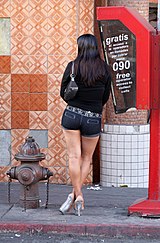
Tijuana is the most populous city in the state of Baja California, located on the northwestern Pacific Coast of Mexico. Tijuana is the municipal seat of the Tijuana Municipality and the hub of the Tijuana metropolitan area. It has a close proximity to the Mexico–United States border, which is part of the San Diego–Tijuana metro area.

De Wallen is the largest and best known red-light district in Amsterdam. It consists of a network of alleys containing approximately 300 one-room cabins rented by prostitutes who offer their sexual services from behind a window or glass door, typically illuminated with red lights and blacklight. Window prostitution is the most visible and typical kind of red-light district sex work in Amsterdam.
Boy's Town,, is a commercial district in the border town of Nuevo Laredo, Tamaulipas, Mexico, serving primarily as a "zone of tolerance" in the city for legal prostitution, and also a variety of other nocturnal entertainment. It is a walled compound containing three short east-west streets and two short north-south streets. It houses a range of brothels, bars, restaurants, small stores, a small police station, and a health clinic. It is located near the intersection of Monterrey and Anahuac Streets, about 5 km southwest of International Bridge #1. Providencia Cantu was the one who came up with the name. She used to own a place there named "El Baston".
Sin City is a nickname that may be applied to an urban area that caters to various vices. These vices may be legal or illegal activities which are tolerated.

Baltimore's The Block is a stretch on the 400 block of East Baltimore Street in Baltimore, Maryland, containing several strip clubs, sex shops, and other adult entertainment merchants. During the 19th century, Baltimore was filled with brothels, and in the first half of the 20th century, it was famous for its burlesque houses. It was a noted starting point and stop-over for many noted burlesque dancers, including the likes of Blaze Starr.

Zona Rosa is an area in Mexico City which is known for its shopping, nightlife, LGBT community, and its recently established Korean community. The larger official neighborhood it is part of is Colonia Juárez, located just west of the historic center of Mexico City.
Prostitution in Hong Kong is itself legal, but organised prostitution is illegal, as there are laws against keeping a vice establishment, causing or procuring another to be a prostitute, living on the prostitution of others, or public solicitation.
The Stingaree was a neighborhood in downtown San Diego from the boom of the 1880s until it was demolished during a vice eradication campaign of 1916. It was the site of the city's Chinatown. Because of this, and it's working class origins, it had a reputation as the home to the city's "undesirables", including prostitutes, pimps, drug dealers and gamblers. Additionally, the neighborhood was home to many other working-class citizens, and was in the center of a wider blue-collar residential area encompassing much of the city south of Broadway.
Prostitution in Singapore in itself is not illegal, but various prostitution-related activities are criminalized. This includes public solicitation, living on the earnings of a prostitute and maintaining a brothel. In practice, police unofficially tolerate and monitor a limited number of brothels. Prostitutes in such establishments are required to undergo periodic health checks and must carry a health card.
Prostitution in Guatemala is legal but procuring is prohibited. There is an offence of “aggravated procuring” where a minor is involved. Keeping a brothel is not prohibited.

Prostitution in Mexico is legal under Federal Law. Each of the 31 states enacts its own prostitution laws and policies. Thirteen of the states of Mexico allow and regulate prostitution. Prostitution involving minors under 18 is illegal. Some Mexican cities have enacted "tolerance zones" which allow regulated prostitution and function as red-light districts. In Tuxtla Gutiérrez, capital of the state of Chiapas, there is a state-run brothel at the Zona Galáctica(Galactic Zone). In most parts of the country, pimping is illegal, although pimp-worker relationships still occur, sometimes under female pimps called "madrotas"("Big Mothers"). The government provides shelter for former prostitutes.
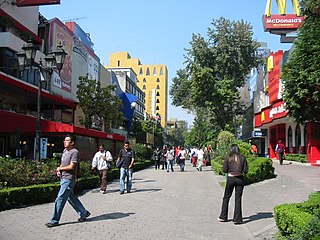
Colonia Juárez is one of the better–known neighborhoods or colonias in the Cuauhtémoc borough of Mexico City. The neighborhood is shaped like a long triangle with the boundaries: Paseo de la Reforma on the north, Avenida Chapultepec on the south, and Eje 1 Poniente on the east.
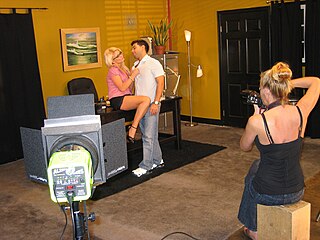
The sex industry consists of businesses that either directly or indirectly provide sex-related products and services or adult entertainment. The industry includes activities involving direct provision of sex-related services, such as prostitution, strip clubs, host and hostess clubs, and sex-related pastimes, such as pornography, sex-oriented men's magazines, women's magazines, sex movies, sex toys, and fetish or BDSM paraphernalia. Sex channels for television and pre-paid sex movies for video on demand, are part of the sex industry, as are adult movie theaters, sex shops, peep shows, and strip clubs. The sex industry employs millions of people worldwide, mainly women. These range from the sex worker, also called adult service provider (ASP), who provides sexual services, to a multitude of support personnel.
The legal status of striptease varies considerably among different countries and the various jurisdictions of the United States. Striptease is considered a form of public nudity and subject to changing legal and cultural attitudes on moral and decency grounds. Some countries do not have any restrictions on performances of striptease. In some countries, public nudity is outlawed directly, while in other countries it may be suppressed or regulated indirectly through devices such as restrictions on venues through planning laws, or licensing regulations, or liquor licensing and other restrictions.
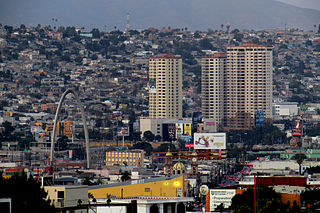
Downtown Tijuana, officially Colonia Zona Centro, is an official neighborhood of Tijuana, Mexico. It is located within the Central Borough of the city, which is immediately southwest of the San Ysidro Port of Entry. It is bordered by Calle Artículo 123 and the Zona Norte neighborhood on the north, by Calle Ocampo and Zona Este and Zona Río on the east, and by the colonias (neighborhoods) Castillo, Lindavista, Altamira, Independencia, Morelos, and Juárez on the west and south. Avenida Revolución is the main tourist thoroughfare while Avenida Constitución is a main traditional shopping thoroughfare.
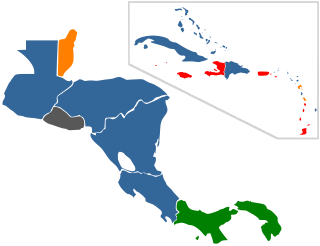
Legality of prostitution in the Americas varies by country. Most countries only legalized prostitution, with the act of exchanging money for sexual services legal. The level of enforcement varies by country. One country, the United States, is unique as legality of prostitution is not the responsibility of the federal government, but rather state, territorial, and federal district's responsibility.
Young black women of the Harlem Renaissance lived with uncertainty of their rights and their roles at a time in which women began to question their sexuality in fear of facing the scrutiny. The women of Harlem began questioning their equal rights and freedom of sexual expression. One occupation that flourished was prostitution. In the early 1900s, New York City thrived with prostitution. Amidst the artistic spectrum of the Harlem Renaissance, the occupation of prostitution created an underlying tension for African American women and their right to solicit their bodies for profit. Preceding World War One, American ideology of sexuality was restrained by religion and denial. Sex was a private matter and was deemed taboo outside of procreation. Idealized notions of the sexual union, however, made non-procreative sex lustful and demeaning. This way of thinking immediately pushes prostitution into the spectrum of being a sinful act and portraying the act in a demeaning manner.
Prostitution in the Dutch Caribbean is legal and regulated. At least 500 foreign women are reportedly working in prostitution throughout the islands. Bonaire, Sint Eustatius, and Curaçao are sex tourism destinations.
The British Overseas Territories (BOT) or alternatively, United Kingdom Overseas Territories (UKOTs), are 14 territories under the jurisdiction and sovereignty of the United Kingdom. They are the parts of the British Empire that have not been granted independence or have voted to remain British territories. These territories do not form part of the United Kingdom. Most of the inhabited territories are internally self-governing, with the UK retaining responsibility for defence and foreign relations. The rest are either uninhabited or have a transitory population of military or scientific personnel.







